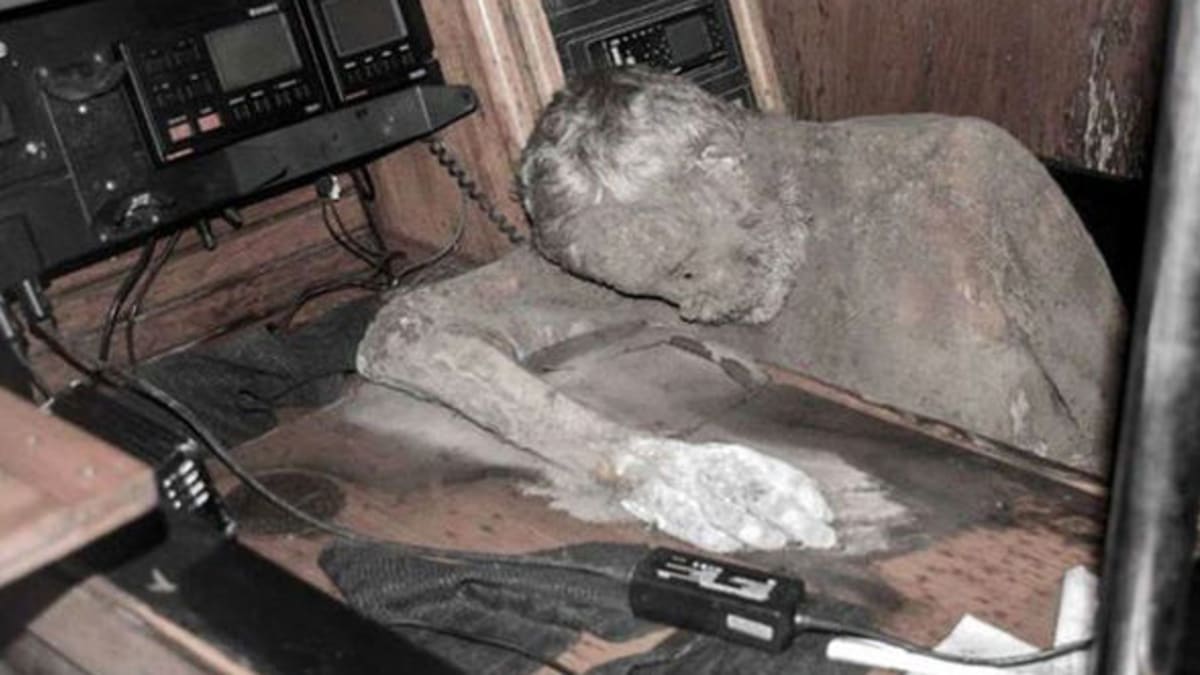The seas have long been a source of mystery, with tales of ghost ships captivating imaginations for centuries. In a remarkable and chilling discovery, an 18th-century ship was recently found adrift in the icy waters of the Arctic, and inside was something far more astounding—a perfectly preserved frozen body believed to be the ship’s captain. This incredible find has raised numerous questions about what led to the tragic fate of the crew and how the body of the captain remained intact after hundreds of years.

The Discovery: A Ghost Ship in the Arctic
The ghost ship, identified as the “Erebus”, was located by an expedition team exploring the uncharted areas of the Arctic. The ship appeared to be in surprisingly good condition, considering its age. The thick ice had encased the ship, preserving much of its structure as it drifted aimlessly for decades, if not centuries. Researchers were able to board the vessel and make a shocking discovery deep within its hull—the body of the captain, frozen in time.
With no signs of recent human activity or tampering, it was clear that the ship had been abandoned for centuries, leading experts to suspect that it belonged to a missing expedition from the late 1700s. The mummified remains of the captain were found in what appeared to be his quarters, slumped over a wooden desk as if he had perished while writing one last entry in the ship’s logbook.
Preservation of the Frozen Captain
What makes this discovery particularly extraordinary is the state in which the captain’s body was found. The subzero Arctic temperatures had perfectly preserved the body, creating a natural form of cryogenic freezing. The captain’s features remained remarkably intact, as though he had only recently passed. Even his clothing—a heavy naval coat adorned with gold buttons—was preserved, along with several personal effects scattered around the cabin.
This preservation has provided archaeologists and scientists with a rare opportunity to study 18th-century seafaring life up close. Not only does this find offer insights into the harsh realities faced by sailors of the time, but it also opens a new chapter in understanding the fate of ghost ships lost in remote, inhospitable waters.

A Haunting History: The Captain’s Final Moments
Though the ship’s exact history remains unclear, initial research suggests that it could be linked to a tragic Arctic expedition. The captain’s body was found beside a logbook, and while the writing has deteriorated over the centuries, some entries remain legible. The last few entries describe the crew’s desperate fight for survival as they were stranded in the ice with dwindling supplies.
The final pages hint at frigid temperatures, severe illness among the crew, and desperate attempts to navigate through the icy labyrinth of the Arctic waters. It appears that the crew may have been cut off from escape as the ship became trapped in the ice, leaving them with little hope of rescue. The last written words, attributed to the captain, speak of “the unbearable cold” and “growing madness” among the remaining sailors.
Theories Behind the Ship’s Fate
Theories surrounding the fate of this ill-fated ship range from starvation and exposure to possible mutiny. Some experts believe that the captain may have been one of the last to perish as the ship drifted helplessly in the frozen wasteland. The rest of the crew likely succumbed to the harsh conditions before abandoning the vessel, leaving the captain behind in a final act of duty or despair.
Another possibility is that the ship was part of a larger exploration mission aimed at mapping the Arctic or searching for the elusive Northwest Passage. The late 18th century was a time of ambitious maritime exploration, and many expeditions ventured into the polar regions, only to meet tragic ends. Some speculate that the ghost ship was caught in a violent storm or ice floe, cutting off its route and sealing its fate.
The Ghostly Legend Reborn
Ghost ships have always fascinated maritime historians, but the discovery of the Erebus and its frozen captain brings to life one of the most dramatic tales of survival and loss on the high seas. The legend of ghost ships often speaks of vessels that roam the oceans with no living soul aboard, their crews vanished or dead. In this case, the captain’s body remained behind as a haunting reminder of the unforgiving power of the Arctic and the dangers faced by explorers of that era.
This discovery will likely fuel future expeditions, as researchers search for more clues about the ship’s origin and the ultimate fate of its crew. Could there be more bodies preserved in the frozen depths of the ship, or perhaps other ghost ships still waiting to be discovered under the Arctic ice?

Scientific and Historical Impact
The discovery of the frozen captain is not just a fascinating historical find but also a major scientific opportunity. Researchers now have the chance to study the effects of cryogenic preservation on human remains and understand more about how the body can remain intact in such extreme conditions. The artifacts found aboard the ship, from navigation tools to personal items, also offer a glimpse into the daily lives of sailors in the 18th century.
Conclusion: A Chilling Discovery
The frozen body of the captain aboard the Erebus is a chilling reminder of the perils faced by early explorers and the enduring mysteries of the sea. This groundbreaking find has opened the door to new investigations into long-lost expeditions and the haunting fate of ghost ships. As researchers continue to unravel the secrets of the frozen captain, the story of this 18th-century vessel and its tragic end will live on, captivating future generations with the eternal mystery of the sea.





